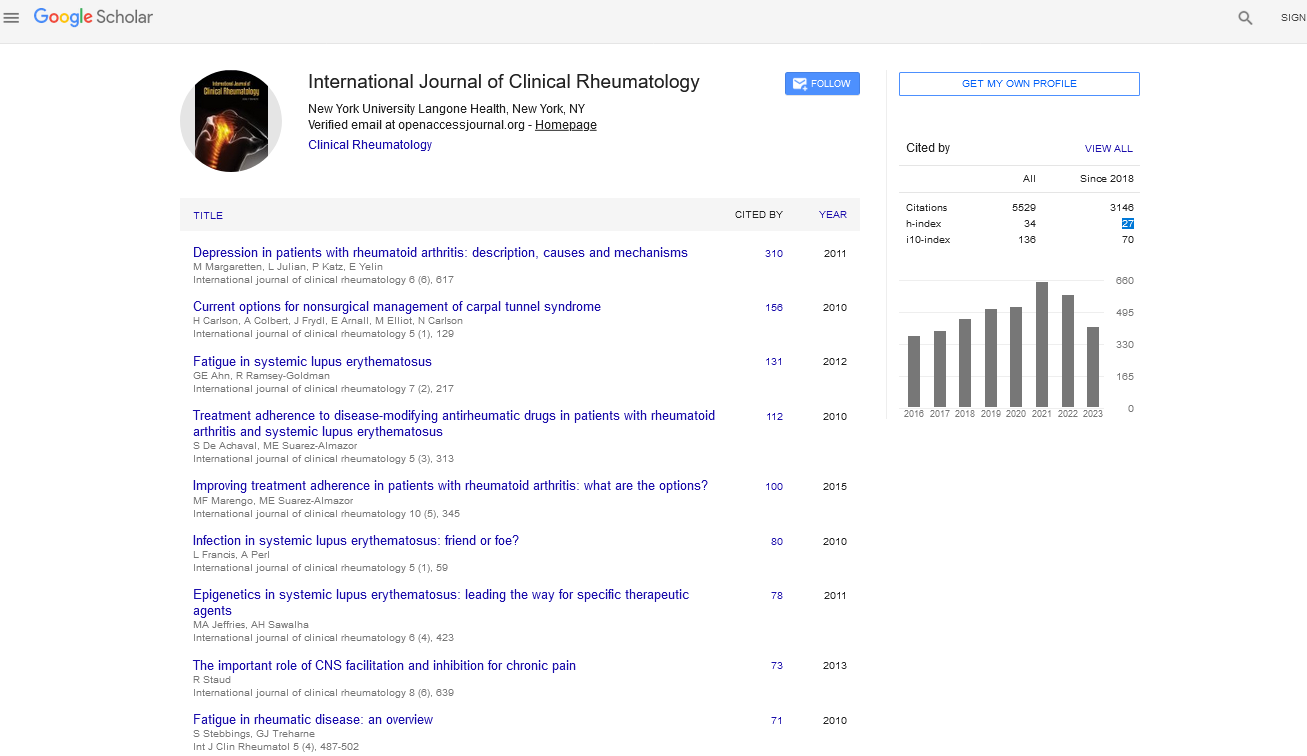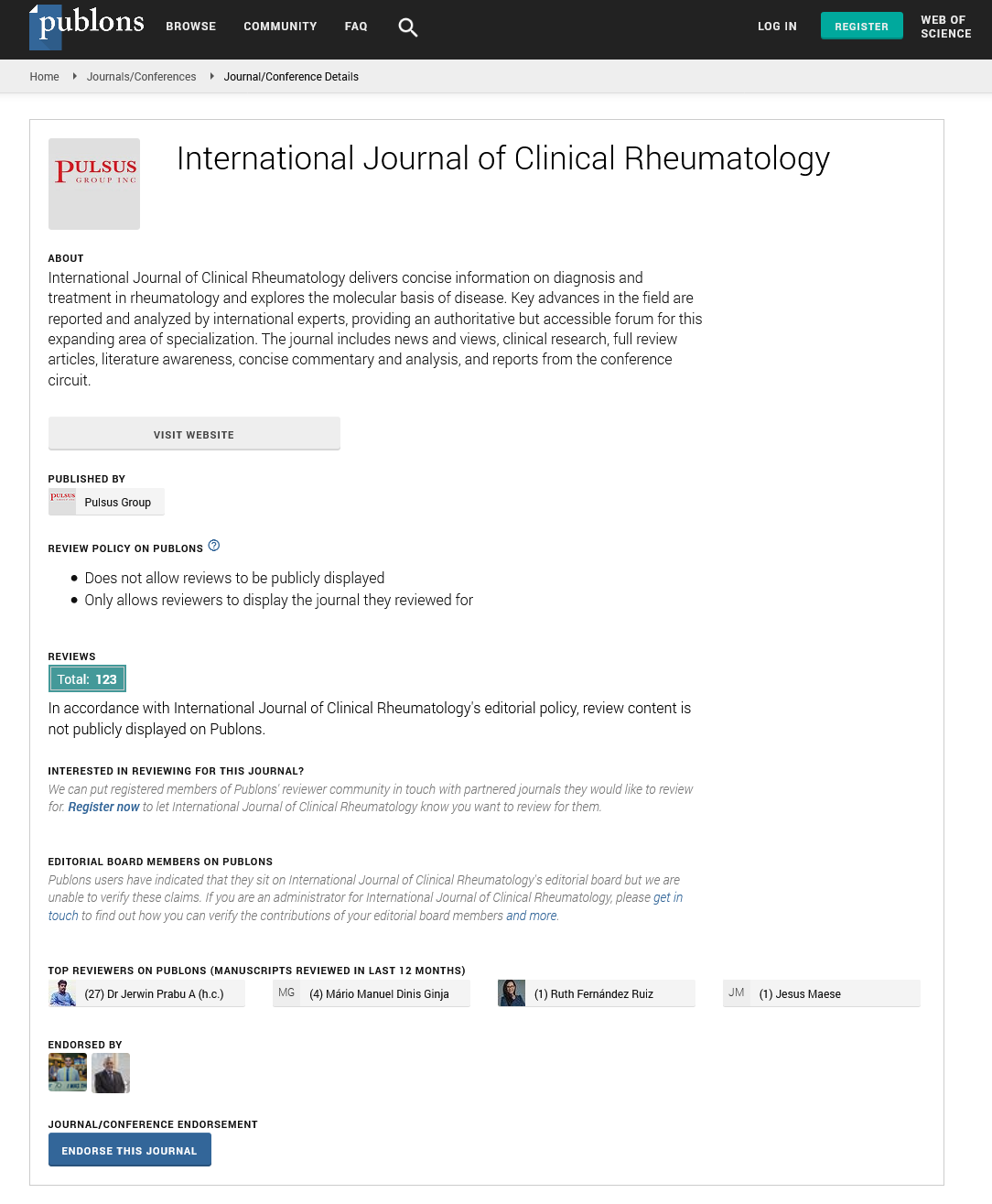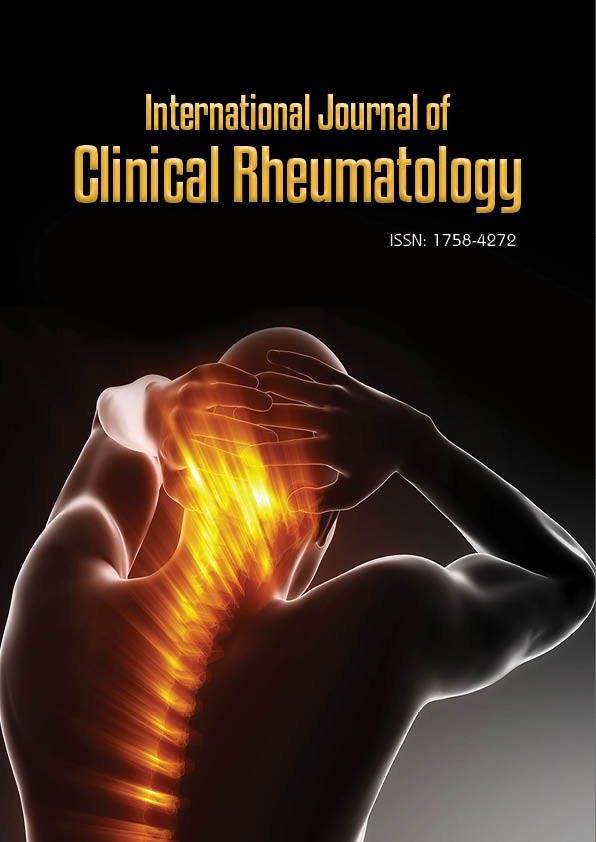Perspective - International Journal of Clinical Rheumatology (2025) Volume 20, Issue 1
Advances in the Diagnosis and Management of Ankylosing Spondylitis: From Traditional to Biological Therapies
Alice Johnson*
Department of Rheumatology, All India Institute of Medical Sciences (AIIMS), New Delhi, India
- *Corresponding Author:
- Alice Johnson
Department of Rheumatology, All India Institute of Medical Sciences (AIIMS), New Delhi, India
E-mail: alice.johnson1234@mail.com
Received: 02-Jan-2025, Manuscript No. fmijcr-25-162978; Editor assigned: 04- Jan-2025, Pre-QC No. fmijcr-25-162978 (PQ); Reviewed: 18-Jan-2025, QC No. fmijcr-25-162978; Revised: 23-Jan-2025, Manuscript No. fmijcr-25-162978 (R); Published: 30-Jan-2025, DOI: 10.37532/1758- 4272.2025.20(1).406-409
Abstract
Ankylosing spondylitis (AS) is a chronic inflammatory disease primarily affecting the axial skeleton, characterized by pain and stiffness in the spine and sacroiliac joints. It is part of a broader group of diseases known as spondyloarthropathies. Early diagnosis and management are crucial to reducing disease progression, improving functional outcomes, and enhancing the quality of life for patients. While nonsteroidal anti-inflammatory drugs (NSAIDs) have historically been the cornerstone of AS management, significant advances in the development of biologic therapies have revolutionized the treatment landscape. This review explores the current advances in the diagnosis and management of AS, including updated diagnostic criteria, imaging techniques, and biologic therapies, such as tumor necrosis factor inhibitors (TNFi) and interleukin-17 (IL-17) inhibitors. It also examines the challenges in managing AS and the future direction of treatment, emphasizing the role of personalized medicine in optimizing therapeutic outcomes.
Keywords
Ankylosing spondylitis● Diagnosis● Biologic therapy● Tumor necrosis factor inhibitors● Interleukin-17 inhibitors● NSAIDs● Spondyloarthropathies● Personalized medicine
Introduction
Ankylosing spondylitis (AS) is a chronic, inflammatory autoimmune disease that primarily affects the spine and sacroiliac joints, leading to pain, stiffness, and eventually, ankylosis (fusion) of the affected joints. AS belongs to the family of diseases known as spondyloarthropathies, which also includes psoriatic arthritis, reactive arthritis, and arthritis associated with inflammatory bowel disease. The hallmark feature of AS is inflammation of the entheses (the sites where tendons and ligaments attach to bone), which can lead to progressive spinal deformity and significant disability. The pathogenesis of AS is primarily driven by genetic factors, most notably the presence of the human leukocyte antigen B27 (HLA-B27) gene, although environmental triggers such as infections may also play a role. The disease typically begins in early adulthood, with a peak onset between 20 and 40 years of age, and is more common in men than women. The clinical presentation of AS includes chronic low back pain and morning stiffness, which can improve with exercise but worsen with rest. As the disease progresses, patients may experience decreased mobility, fatigue, and involvement of other organs, including the eyes (in the form of uveitis) and the cardiovascular system. Early recognition and effective management are essential to preventing long-term disability and improving patient outcomes [1-4].
Diagnostic advances in ankylosing spondylitis
The diagnosis of AS has traditionally been based on clinical features, including chronic inflammatory back pain and a positive family history of spondyloarthropathy. However, diagnostic challenges persist, as AS symptoms overlap with those of other musculoskeletal conditions, such as degenerative disc disease and fibromyalgia.
Updated diagnostic criteria: In 2016, the Assessment of SpondyloArthritis International Society (ASAS) developed updated criteria for diagnosing axial spondyloarthritis (axSpA), the broader category under which AS falls. The ASAS criteria incorporate clinical features, laboratory tests, and imaging findings. A positive HLA-B27 test is supportive but not diagnostic, as not all AS patients are HLA-B27 positive. Recent studies have emphasized the importance of early diagnosis, as timely intervention can significantly improve patient outcomes [5,6].
Imaging techniques: Magnetic resonance imaging (MRI) has become a critical tool in diagnosing early AS, particularly for detecting inflammation in the sacroiliac joints and spine before the development of bony changes visible on conventional radiography. MRI can detect bone marrow edema, a key early sign of inflammation, and may aid in diagnosing patients who have symptoms but no radiographic evidence of AS. X-ray imaging remains essential for evaluating structural changes in established disease, such as the formation of syndesmophytes (bony growths) and spinal fusion. However, MRI and computed tomography (CT) scans are more sensitive for detecting early signs of disease and monitoring treatment response [7].
Management of ankylosing spondylitis
Management of AS aims to reduce inflammation, alleviate pain, and prevent disability. Traditionally, treatment focused on the use of nonsteroidal anti-inflammatory drugs (NSAIDs) for symptom control, with the addition of physical therapy to improve flexibility and posture. However, the advent of biologic therapies has revolutionized the approach to AS management.
Nonsteroidal anti-inflammatory drugs (NSAIDs): NSAIDs remain the first-line treatment for AS, as they provide significant relief from pain and stiffness. Although they do not alter the course of the disease, NSAIDs can significantly improve quality of life by reducing inflammatory pain. Commonly used NSAIDs include ibuprofen, naproxen, and celecoxib. However, long-term use of NSAIDs can lead to gastrointestinal, renal, and cardiovascular side effects, necessitating regular monitoring.
Biologic therapies: Biologic agents have transformed the treatment landscape for AS, offering more targeted interventions aimed at the underlying inflammatory processes.
Tumor necrosis factor inhibitors (TNFi): TNFi therapies, including infliximab, adalimumab, and etanercept, target tumor necrosis factor-alpha (TNF-α), a key pro-inflammatory cytokine involved in the pathogenesis of AS. TNFi agents have been shown to reduce disease activity, improve physical function, and slow the progression of structural damage. Several clinical trials have demonstrated the efficacy of TNFi therapies in both early and established AS, making them the standard of care for patients with moderate-to-severe disease.
Interleukin-17 Inhibitors (IL-17i): More recently, interleukin-17 inhibitors, such as secukinumab and ixekizumab, have been approved for the treatment of AS. IL-17 is another cytokine that plays a critical role in driving inflammation in AS. IL-17 inhibitors have demonstrated substantial benefits in improving spinal mobility, reducing pain, and preventing disease progression in patients who have not responded to TNFi therapies. The introduction of IL-17 inhibitors has expanded the therapeutic options for AS, providing an alternative for patients with TNFi resistance or intolerance. Although biologic agents have revolutionized AS treatment, other disease-modifying antirheumatic drugs (DMARDs), such as sulfasalazine and methotrexate, have limited efficacy in treating axial disease. These drugs may be useful for peripheral arthritis or extra-articular manifestations of AS but are generally not effective for controlling the axial component of the disease. Physical therapy plays a crucial role in the management of AS. A structured exercise program designed to improve spinal flexibility, posture, and strength can help reduce pain and stiffness. Regular aerobic exercises, stretching, and strengthening exercises are recommended to maintain mobility and function. The use of postural training and spinal exercises can also prevent spinal deformities and improve long-term outcomes [8-10].
Discussion
Ankylosing spondylitis is a debilitating disease that can significantly affect patients' quality of life if left untreated. Advances in the diagnosis of AS, particularly the use of MRI, have allowed for earlier detection, which is crucial for initiating timely interventions. The development of biologic therapies has revolutionized AS treatment, offering patients more effective and targeted therapies that can improve outcomes and slow disease progression. TNF inhibitors remain the cornerstone of biologic therapy for AS, but newer agents targeting IL-17 have expanded treatment options, especially for patients who do not respond to TNF inhibitors. As the understanding of AS pathogenesis continues to evolve, personalized treatment strategies based on genetic and immunologic factors may further optimize patient outcomes. However, challenges remain in managing AS, including access to biologic therapies, treatment costs, and the potential for side effects associated with long-term biologic use. Future research should focus on identifying biomarkers for treatment response, improving patient selection for biologic therapies, and exploring combination therapies to enhance efficacy.
Conclusion
Ankylosing spondylitis is a chronic inflammatory disease that requires early diagnosis and effective management to prevent long-term disability. Advances in diagnostic techniques, including MRI and updated classification criteria, have facilitated earlier detection and intervention. Biologic therapies, such as TNF inhibitors and IL-17 inhibitors, have significantly improved the management of AS, offering targeted treatments that reduce inflammation, improve functional outcomes, and prevent disease progression. Moving forward, personalized treatment approaches and ongoing clinical research will be key to optimizing care for patients with AS.
References
- Corrales A, González Juanatey C, Peiró ME et al. Carotid ultrasound is useful for the cardiovascular risk stratification of patients with rheumatoid arthritis: results of a population-based study. Ann Rheum Dis. 73,722-7 (2014).
- Kumar BS, Suneetha P, Mohan A et al. Comparison of Disease Activity Score in 28 joints with ESR (DAS28), Clinical Disease Activity Index (CDAI), Health Assessment Questionnaire Disability Index (HAQ-DI) & Routine Assessment of Patient Index Data with 3 measures (RAPID3) for assessing disease activity in patients with rheumatoid arthritis at initial presentation. Indian J Med Res. 146, S57-S62 (2017).
- Smolen JS, Breedveld FC, Schiff MH et al. A simplified disease activity index for rheumatoid arthritis for use in clinical practice. Rheumatology.42, 244-57 (2003).
- Ndrepepa G, Colleran R, Kastrati A. Gamma-glutamyl transferase and the risk of atherosclerosis and coronary heart disease. Clin Chim Acta. 476,130-8 (2018).
- Kunutsor SK, Apekey TA, Seddoh D. Gamma glutamyltransferase and metabolic syndrome risk: a systematic review and dose-response meta-analysis. Int J Clin Pract. 69,136-44 (2015).
- Franzini M, Scataglini I, Ricchiuti A et al. Association between plasma gamma-glutamyltransferase fractions and metabolic syndrome among hypertensive patients. Sci Rep. 7-12003 (2017).
- Wang J, Zhang D, Huang R et al. Gamma-glutamyltransferase and the risk of cardiovascular mortality: a dose-response meta-analysis of prospective studies. PLoS One.12-e0172631 (2017).
- Emdin M, Passino C, Michelassi C et al. Prognostic value of serum gamma-glutamyl transferase activity after myocardial infarction. Eur Heart J. 22, 1802-7(2001).
- Spooner RJ, Smith DH, Bedford D et al. Serum gamma-glutamyltransferase and alkaline phosphatase in rheumatoid arthritis. J Clin Pathol.35, 638-41(1982).
- Lowe JR, Pickup ME, Dixon JS et al. Gamma-glutamyl transpeptidase levels in arthritis: a correlation with clinical and laboratory indices of disease activity. Ann Rheum Dis. 37,428-31(1978).
Indexed at, Google Scholar, Crossref
Indexed at, Google Scholar, Crossref
Indexed at, Google Scholar, Crossref
Indexed at, Google Scholar, Crossref
Indexed at, Google Scholar, Crossref
Indexed at, Google Scholar, Crossref
Indexed at, Google Scholar, Crossref
Indexed at, Google Scholar, Crossref
Indexed at, Google Scholar, Crossref


